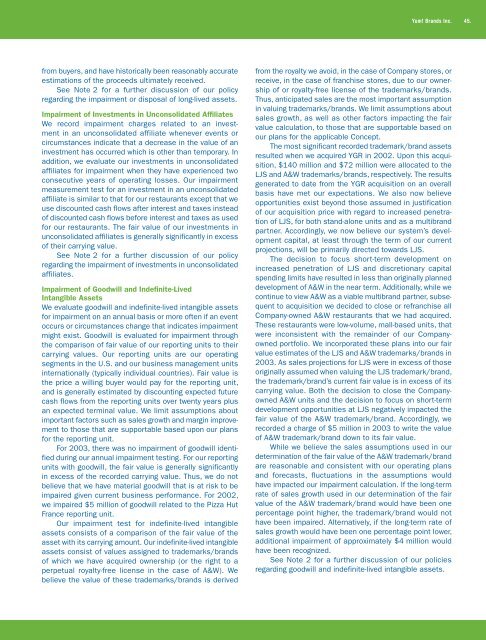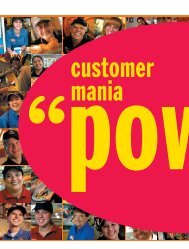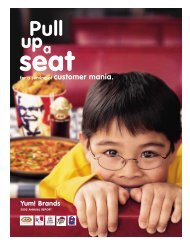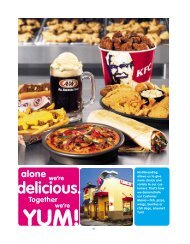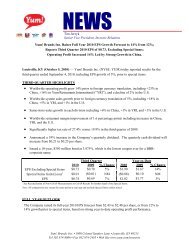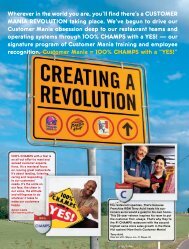Multibranding - Yum!
Multibranding - Yum!
Multibranding - Yum!
You also want an ePaper? Increase the reach of your titles
YUMPU automatically turns print PDFs into web optimized ePapers that Google loves.
from buyers, and have historically been reasonably accurate<br />
estimations of the proceeds ultimately received.<br />
See Note 2 for a further discussion of our policy<br />
regarding the impairment or disposal of long-lived assets.<br />
Impairment of Investments in Unconsolidated Affiliates<br />
We record impairment charges related to an investment<br />
in an unconsolidated affiliate whenever events or<br />
circumstances indicate that a decrease in the value of an<br />
investment has occurred which is other than temporary. In<br />
addition, we evaluate our investments in unconsolidated<br />
affiliates for impairment when they have experienced two<br />
consecutive years of operating losses. Our impairment<br />
measurement test for an investment in an unconsolidated<br />
affiliate is similar to that for our restaurants except that we<br />
use discounted cash flows after interest and taxes instead<br />
of discounted cash flows before interest and taxes as used<br />
for our restaurants. The fair value of our investments in<br />
unconsolidated affiliates is generally significantly in excess<br />
of their carrying value.<br />
See Note 2 for a further discussion of our policy<br />
regarding the impairment of investments in unconsolidated<br />
affiliates.<br />
Impairment of Goodwill and Indefinite-Lived<br />
Intangible Assets<br />
We evaluate goodwill and indefinite-lived intangible assets<br />
for impairment on an annual basis or more often if an event<br />
occurs or circumstances change that indicates impairment<br />
might exist. Goodwill is evaluated for impairment through<br />
the comparison of fair value of our reporting units to their<br />
carrying values. Our reporting units are our operating<br />
segments in the U.S. and our business management units<br />
internationally (typically individual countries). Fair value is<br />
the price a willing buyer would pay for the reporting unit,<br />
and is generally estimated by discounting expected future<br />
cash flows from the reporting units over twenty years plus<br />
an expected terminal value. We limit assumptions about<br />
important factors such as sales growth and margin improvement<br />
to those that are supportable based upon our plans<br />
for the reporting unit.<br />
For 2003, there was no impairment of goodwill identified<br />
during our annual impairment testing. For our reporting<br />
units with goodwill, the fair value is generally significantly<br />
in excess of the recorded carrying value. Thus, we do not<br />
believe that we have material goodwill that is at risk to be<br />
impaired given current business performance. For 2002,<br />
we impaired $5 million of goodwill related to the Pizza Hut<br />
France reporting unit.<br />
Our impairment test for indefinite-lived intangible<br />
assets consists of a comparison of the fair value of the<br />
asset with its carrying amount. Our indefinite-lived intangible<br />
assets consist of values assigned to trademarks/brands<br />
of which we have acquired ownership (or the right to a<br />
perpetual royalty-free license in the case of A&W). We<br />
believe the value of these trademarks/brands is derived<br />
<strong>Yum</strong>! Brands Inc. 45.<br />
from the royalty we avoid, in the case of Company stores, or<br />
receive, in the case of franchise stores, due to our ownership<br />
of or royalty-free license of the trademarks/brands.<br />
Thus, anticipated sales are the most important assumption<br />
in valuing trademarks/brands. We limit assumptions about<br />
sales growth, as well as other factors impacting the fair<br />
value calculation, to those that are supportable based on<br />
our plans for the applicable Concept.<br />
The most significant recorded trademark/brand assets<br />
resulted when we acquired YGR in 2002. Upon this acquisition,<br />
$140 million and $72 million were allocated to the<br />
LJS and A&W trademarks/brands, respectively. The results<br />
generated to date from the YGR acquisition on an overall<br />
basis have met our expectations. We also now believe<br />
opportunities exist beyond those assumed in justification<br />
of our acquisition price with regard to increased penetration<br />
of LJS, for both stand-alone units and as a multibrand<br />
partner. Accordingly, we now believe our system’s development<br />
capital, at least through the term of our current<br />
projections, will be primarily directed towards LJS.<br />
The decision to focus short-term development on<br />
increased penetration of LJS and discretionary capital<br />
spending limits have resulted in less than originally planned<br />
development of A&W in the near term. Additionally, while we<br />
continue to view A&W as a viable multibrand partner, subsequent<br />
to acquisition we decided to close or refranchise all<br />
Company-owned A&W restaurants that we had acquired.<br />
These restaurants were low-volume, mall-based units, that<br />
were inconsistent with the remainder of our Companyowned<br />
portfolio. We incorporated these plans into our fair<br />
value estimates of the LJS and A&W trademarks/brands in<br />
2003. As sales projections for LJS were in excess of those<br />
originally assumed when valuing the LJS trademark/brand,<br />
the trademark/brand’s current fair value is in excess of its<br />
carrying value. Both the decision to close the Companyowned<br />
A&W units and the decision to focus on short-term<br />
development opportunities at LJS negatively impacted the<br />
fair value of the A&W trademark/brand. Accordingly, we<br />
recorded a charge of $5 million in 2003 to write the value<br />
of A&W trademark/brand down to its fair value.<br />
While we believe the sales assumptions used in our<br />
determination of the fair value of the A&W trademark/brand<br />
are reasonable and consistent with our operating plans<br />
and forecasts, fluctuations in the assumptions would<br />
have impacted our impairment calculation. If the long-term<br />
rate of sales growth used in our determination of the fair<br />
value of the A&W trademark/brand would have been one<br />
percentage point higher, the trademark/brand would not<br />
have been impaired. Alternatively, if the long-term rate of<br />
sales growth would have been one percentage point lower,<br />
additional impairment of approximately $4 million would<br />
have been recognized.<br />
See Note 2 for a further discussion of our policies<br />
regarding goodwill and indefinite-lived intangible assets.


